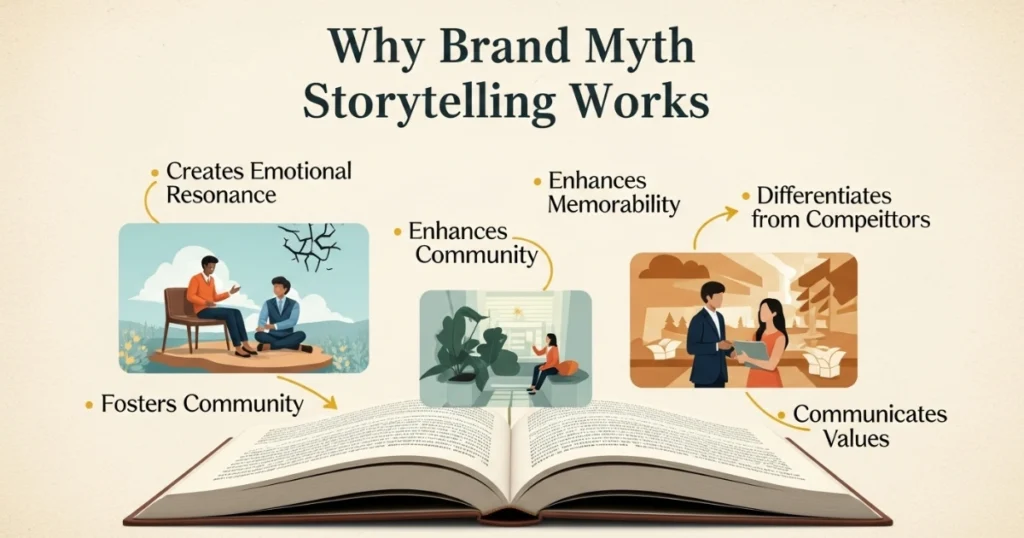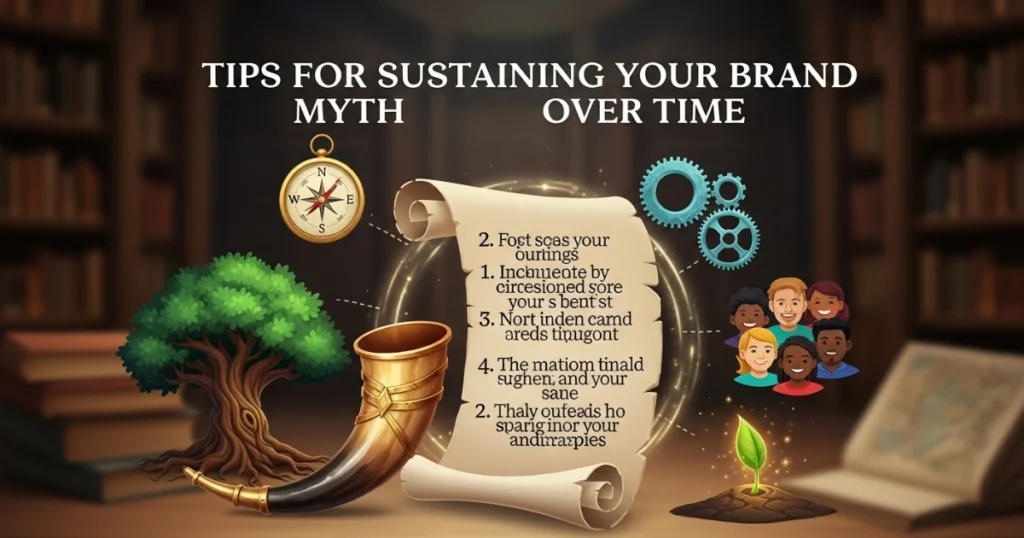
AI Content Creation
Brand Myth Storytelling: Crafting Narratives That Resonate

Contents
- 1 What Is Brand Myth Storytelling?
- 2 Why Brand Myth Storytelling Works
- 3 How to Craft a Compelling Brand Myth
- 4 Implementing Brand Myth Storytelling in Your Marketing
- 5 Overcoming Challenges in Brand Myth Storytelling
- 6 Case Studies of Successful Brand Myth Storytelling
- 7 Measuring the Impact of Brand Myth Storytelling
- 8 Tips for Sustaining Your Brand Myth Over Time
Brand myth storytelling is a powerful tool that transforms how businesses connect with their audiences. By weaving compelling narratives rooted in timeless archetypes, brands can create emotional resonance, foster loyalty, and stand out in a crowded market. Unlike traditional marketing, which often focuses on features or benefits, brand myth storytelling taps into universal human experiences, making your message unforgettable. In this article, we’ll explore the art and science of crafting brand myths, their psychological impact, and practical steps to implement them effectively. Whether you’re a startup or an established company, mastering this approach can elevate your brand’s identity and engagement for maximum impact.
What Is Brand Myth Storytelling?
Brand myth storytelling draws inspiration from ancient myths and archetypes to create narratives that resonate deeply with audiences. These stories go beyond mere advertising; they evoke emotions, values, and aspirations that align with your brand’s identity. By tapping into universal themes—like the hero’s journey, the quest for belonging, or the triumph over adversity—brands can craft stories that feel timeless and authentic.
For example, think of Nike’s “Just Do It” campaign. It’s not just about sneakers; it’s about the hero within every athlete, pushing past limitations to achieve greatness. This narrative aligns with the archetype of the Hero, making it universally relatable. Similarly, Apple’s storytelling often positions its products as tools for the Rebel, empowering individuals to challenge the status quo. These examples show how brand myth storytelling creates a deeper connection with consumers.
Transitioning to the next point, let’s examine why these myths are so effective.
Why Brand Myth Storytelling Works

Psychological Connection
Humans are wired for stories. According to neuroscientists, narratives activate parts of the brain associated with emotion and memory, making them more impactful than facts alone. Brand myth storytelling leverages this by aligning your brand with archetypes that resonate on a subconscious level. For instance, the Caregiver archetype, seen in brands like Johnson & Johnson, evokes trust and nurturing, while the Explorer archetype, used by Jeep, appeals to adventure and freedom.
Emotional Engagement
Stories evoke emotions, and emotions drive decisions. A 2018 study by Harvard Business Review found that emotionally connected customers are 52% more valuable to brands than those who are merely satisfied. By using brand myth storytelling, you create narratives that make consumers feel seen, understood, and inspired. This emotional bond fosters loyalty and encourages repeat engagement.
Differentiation in a Crowded Market
In today’s saturated digital landscape, standing out is challenging. Brand myth storytelling offers a way to differentiate by focusing on meaning rather than features. For instance, Patagonia’s narrative of environmental stewardship sets it apart from competitors, appealing to consumers who value sustainability. This approach builds a unique identity that competitors can’t easily replicate.
Now that we understand why it works, let’s explore how to craft a brand myth.
How to Craft a Compelling Brand Myth

Step 1: Identify Your Brand’s Core Values
Every brand myth starts with a clear understanding of your brand’s values. Ask yourself: What does your brand stand for? What problem does it solve? For example, if you run a fitness brand, your core value might be empowerment or transformation. These values form the foundation of your story.
Step 2: Choose the Right Archetype
Archetypes are universal characters or themes that resonate across cultures. Psychologist Carl Jung identified several archetypes, such as the Hero, the Sage, or the Outlaw. Choose one that aligns with your brand’s values and audience. For instance:
- Hero: Ideal for brands that inspire action or overcoming challenges (e.g., Nike).
- Sage: Perfect for brands that offer wisdom or expertise (e.g., Google).
- Lover: Suited for brands that evoke passion or beauty (e.g., Chanel).
Step 3: Develop a Narrative Arc
A compelling brand myth follows a narrative arc, often inspired by the Hero’s Journey. This structure includes:
- The Call to Adventure: Introduce the problem or desire your audience faces.
- The Struggle: Highlight the challenges they encounter.
- The Resolution: Show how your brand helps them overcome these challenges.
For example, a skincare brand might tell the story of a customer (the Hero) struggling with confidence due to skin issues (the Struggle), who discovers their product and regains their glow (the Resolution).
Step 4: Use Authentic Characters
Your story needs relatable characters—whether it’s your customer, your founder, or even your product personified. Authenticity is key. Share real customer testimonials or behind-the-scenes stories about your brand’s journey to make the narrative relatable.
Step 5: Incorporate Visual and Emotional Elements
Visuals and emotions amplify your story. Use imagery, colors, and symbols that align with your archetype. For example, a brand using the Explorer archetype might incorporate rugged landscapes or open roads in its visuals. Emotionally, focus on feelings like hope, courage, or belonging to connect with your audience.
Next, let’s look at practical ways to implement brand myth storytelling across your marketing channels.
Implementing Brand Myth Storytelling in Your Marketing

Website and Content Marketing
Your website is the heart of your brand’s story. Use your homepage to introduce your brand myth through compelling copy and visuals. For example, a sustainable fashion brand might feature a video of artisans crafting products, emphasizing their Caregiver archetype. Blog posts can expand on your narrative, sharing customer stories or insights that reinforce your values.
Social Media
Social media platforms are ideal for bite-sized storytelling. Share short videos, infographics, or carousel posts that highlight your brand myth. For instance, a coffee brand using the Creator archetype could post behind-the-scenes content about its sourcing process, emphasizing creativity and craftsmanship.
Email Campaigns
Emails allow for personalized storytelling. Segment your audience and tailor your narratives to their needs. For example, a travel brand using the Explorer archetype could send emails with adventure stories tailored to different customer personas, like solo travelers or families.
Advertising
Incorporate your brand myth into ads to create memorable campaigns. Coca-Cola’s “Share a Coke” campaign is a great example, using the Lover archetype to evoke connection and joy. Use storytelling elements like music, visuals, and taglines to reinforce your myth.
Product Packaging
Your product packaging can also tell a story. For example, Method’s eco-friendly cleaning products use playful designs and copy to convey their Jester archetype, making sustainability fun and approachable.
Now, let’s address some common challenges and how to overcome them.
Overcoming Challenges in Brand Myth Storytelling

Challenge 1: Staying Authentic
Inauthentic storytelling can backfire, eroding trust. To avoid this, ensure your narrative aligns with your brand’s actions. For example, if your brand claims to be sustainable, back it up with transparent practices like eco-friendly sourcing.
Challenge 2: Balancing Creativity and Clarity
While creativity is essential, your story must be clear and relatable. Avoid overly complex narratives that confuse your audience. Test your story with a small group to ensure it resonates.
Challenge 3: Consistency Across Channels
Inconsistent storytelling can dilute your brand’s impact. Create a brand style guide that outlines your narrative, tone, and visuals to ensure consistency across all touchpoints.
Transitioning to the next section, let’s explore real-world examples of successful brand myth storytelling.
Case Studies of Successful Brand Myth Storytelling
Nike: The Hero’s Journey
Nike’s brand myth revolves around the Hero archetype, inspiring customers to overcome obstacles and achieve greatness. Their campaigns, like “Find Your Greatness,” feature everyday athletes pushing their limits, making the narrative relatable and aspirational. This approach has helped Nike build a loyal community and dominate the athletic wear market.
Patagonia: The Caregiver Archetype
Patagonia’s storytelling focuses on environmental stewardship, aligning with the Caregiver archetype. Their “Don’t Buy This Jacket” campaign urged consumers to rethink consumption, reinforcing their commitment to sustainability. This bold narrative has earned them a dedicated following among eco-conscious consumers.
Airbnb: The Explorer Archetype
Airbnb’s brand myth encourages exploration and belonging, using the Explorer archetype. Their “Live There” campaign invited travelers to immerse themselves in local cultures, creating an emotional connection with their audience. This storytelling has helped Airbnb differentiate itself in the competitive travel industry.
These examples show how brand myth storytelling can drive engagement and loyalty. Next, let’s discuss how to measure its impact.
Measuring the Impact of Brand Myth Storytelling
To gauge the success of your storytelling efforts, track the following metrics:
- Engagement: Monitor likes, shares, and comments on social media posts to measure audience interaction.
- Brand Sentiment: Use tools like Brandwatch to analyze how customers perceive your brand.
- Conversion Rates: Track how storytelling impacts sales or sign-ups, especially in campaigns.
- Customer Retention: Measure repeat purchases or loyalty program engagement to assess long-term impact.
By analyzing these metrics, you can refine your narrative for maximum effectiveness.
Tips for Sustaining Your Brand Myth Over Time

Evolve with Your Audience
As your audience’s needs change, adapt your story while staying true to your core values. For example, Dove’s “Real Beauty” campaign evolved to include diverse representations of beauty, keeping the narrative relevant.
Involve Your Community
Encourage your audience to share their stories, reinforcing your brand myth. User-generated content, like customer testimonials or social media challenges, can amplify your narrative.
Stay Consistent but Flexible
Consistency builds recognition, but flexibility allows for innovation. Update your visuals or messaging to stay fresh while maintaining your core archetype.
Conclusion
Brand myth storytelling is more than a marketing tactic; it’s a way to create lasting connections with your audience. By rooting your narrative in universal archetypes, you can evoke emotions, differentiate your brand, and foster loyalty. Start by identifying your brand’s values, choosing an archetype, and crafting a compelling narrative arc. Implement your story across channels, stay authentic, and measure its impact to refine your approach. With these steps, your brand can create a myth that resonates for years to come, ensuring maximum impact in a competitive world.


Cultural Mirror Content: Reflecting Society in Digital Media
Updated on September 11, 2025
Read More